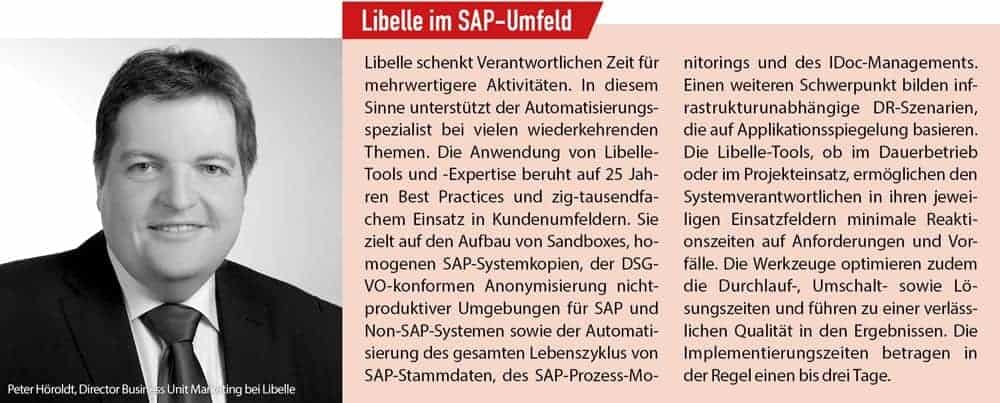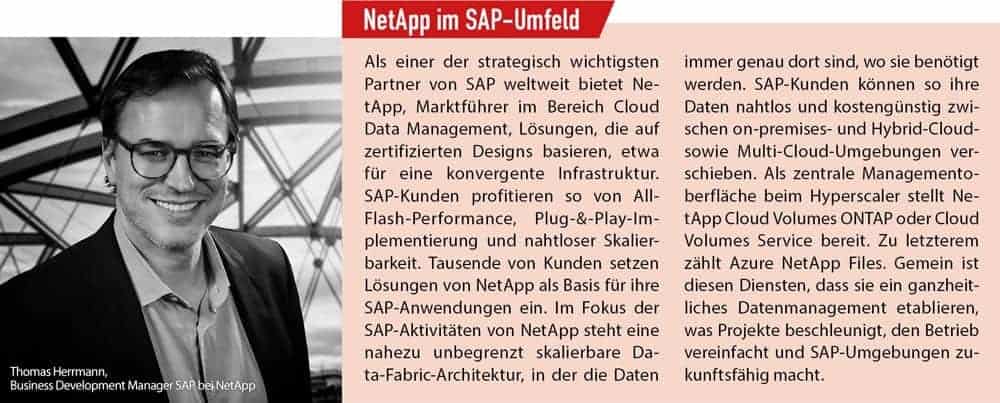Hybrid cloud views
![[shutterstock.com: 1029067051, I'm friday]](https://e3mag.com/wp-content/uploads/2020/07/shutterstock_1029067051.jpg)

How this works in practice can be seen, for example, in the transformation from SAP ERP to S/4 Hana or from on-premises to a hybrid multi-cloud environment.
Hybrid operation is predestined to approach cloud operation step by step. In this way, companies gain experience and gain confidence in their own and external processes.
In practice, two approaches are emerging for this: On the one hand, certain system lines remain local, while others are operated in the cloud. On the other hand, a user company runs productive and other critical systems, such as those for reporting and analysis, in its own data center or in the private cloud at the service provider.
The non-production systems such as quality assurance (QA), test and development (Dev) and others flexibly map dynamic resources to the cloud.
However, many an SAP customer worries that their own corporate IT could become too complex as a result of the cloud. But after good planning, which should include a detailed operational concept for workload shifting and utilization, these fears can be dispelled - and make IT fit for the future.
The main focus is on integrating microservices from different hyperscalers and SAP according to business needs. These include Internet of Things (IoT) devices and applications for blockchain, big data analytics and artificial intelligence (AI).
This requires an open and flexible architecture that can be efficiently represented with a hybrid SAP landscape.
Hybrid environment transform
There is no "ideal" individual hybrid SAP environment. The options for using the cloud are many and vary according to business requirements in terms of performance, scalability, redundancy and compliance.

SAP customers who, for example, do not operate a second failure data center but have a disaster & recovery (DR) scenario as a service level agreement (SLA) requirement can place their data in the cloud and switch over in the event of a disaster. In addition, the public cloud has proven itself primarily for development and testing purposes.
But this picture is changing completely. More and more important applications are being moved to the cloud and cloud-native applications regulate their availability themselves.
SAP is also going down this path, which cloud-critical SAP customers will inevitably have to come to terms with. Implementing the hybrid approach offers them the option of keeping up with the times in terms of technology deployment and innovative capability.
Implementation hurdles
In many places, setting up a functioning hybrid SAP environment can still fail due to the physical connection, because the necessary bandwidth is lacking. Other typical obstacles are the identification of suitable systems or detailed planning.
For example, the strategic cloud architecture should not only provide for a hypervisor (vendor lock-in). It is also important to provide the same functionalities for on-premises as well as in the cloud and to guarantee the performance of the products used.
Two other aspects will determine how practical the hybrid cloud becomes: the release supported by SAP and its support, and the integration of external solutions with SAP applications.
Managing hybrid landscapes is challenging. On-premises and in the cloud, different SLAs and operating models apply. Moving data from the data center to the cloud and back again takes effort.
Data Fabric from NetApp, the leader in cloud data services, brings these two worlds together while keeping the operating models the same. This way, replicating data to the cloud - and back again if desired - is simple, fast and transparent. This also applies to multi-cloud scenarios.
The practice
The transformation from SAP ERP/ECC 6.0 (Suite 7) to S/4 or from on-premises to a hybrid or multi-cloud can be used to show how companies can achieve the goal of a hybrid SAP landscape.
In this project example, T-Systems, Europe's leading digital service provider for information and communications technology, accompanies the migration path, implements and provides managed services, while Libelle, a specialist for automation in the SAP environment, and NetApp primarily support with their data management tools and services.
To take individual circumstances into account, T-Systems accompanies the transformation path, from planning and implementation to operation on multi-clouds and subsequent application support.
For the transition to a multi-cloud, T-Systems sets up an agile and flexible platform via SAP application templates, e.g. for S/4 Hana or BW/4 Hana. The predefined SAP software appliances are provided on an SAP-certified T-Systems Public Cloud with the usual operational quality.
AWS, Microsoft Azure and OpenStack with the Open Telekom Cloud are possible. Google Cloud will be added in the course of the year. T-Systems will relieve the IT department and take over cloud orchestration as well as the secure management and interaction of workloads between the different cloud landscapes.
The tools of the Libelle Master Data Services Suite support housekeeping in the master data of the legacy systems in order to declutter the system landscape in the shortest possible time.
This is followed by the end-to-end setup and regular refreshes of the test environments for the ERP and S/4 environments using Libelle SystemClone (LSCL) and Libelle SystemCopy (LSC) as further solutions from the Libelle toolbox.

This also includes DSGVO-compliant anonymization for realistic testing. In addition, these solutions transfer application-related adaptations to the respective systems in the cloud infrastructure.
The initial set-up of these end-to-end processes is reduced to minutes to a few hours, and the repeated execution in operational or project mode to a simple push of a button.
The advantages for SAP users
NetApp Data Fabric tools replicate SAP systems from on-premises to the cloud through incremental data replication. For the migration to Azure, the Azure NetApp Files (ANF) certified for Hana, which are designed for Microsoft and consist of NetApp storage, come to the fore.
Among other things, this service offers the possibility of application-consistent backups, which are very fast and have a very low impact on storage capacity and are neutral for the performance of the source system.
Via a simple API command or via the Azure portal, SAP customers can create a clone that builds on such a backup copy. This storage clone is created in seconds and can be easily integrated into the Libelle SystemCopy pre- and post-copy automation operations: The interaction of NetApp and Libelle enables seamless end-to-end refreshes virtually "out of the box".
The example of "system copies" shows how the integration of best-practice tools reduces complex processes from days to minutes, both in regular day-to-day business and in project operations - regardless of whether on-premises or in the (hybrid/multi-) cloud.

Users benefit from the coordinated approach and experience that unites the three partners NetApp, Libelle and T-Systems. T-Systems provides end-to-end support and management for the entire hybrid SAP landscape, for example as a managed SAP PaaS (Platform as a Service) with a self-service portal and pay-as-you-go pricing models.
For this, the important tools of the other two partners are also used. The challenge of managing multiple platforms in parallel and coordinating them ideally with each other is eliminated for the SAP user customer.
This gives enterprises a reliable and secure hybrid cloud environment that includes the right public and private cloud components alongside their own infrastructure components.
Such a hybrid SAP landscape can be flexibly adapted as soon as the market changes. From a strategic point of view, for some companies the hybrid cloud approach will already represent the final expansion stage, while for others it will serve as the perfect starting point in multi-cloud scenarios.




